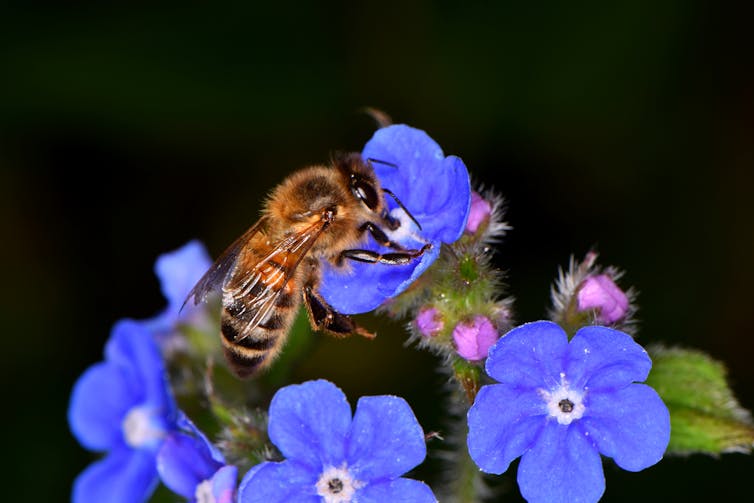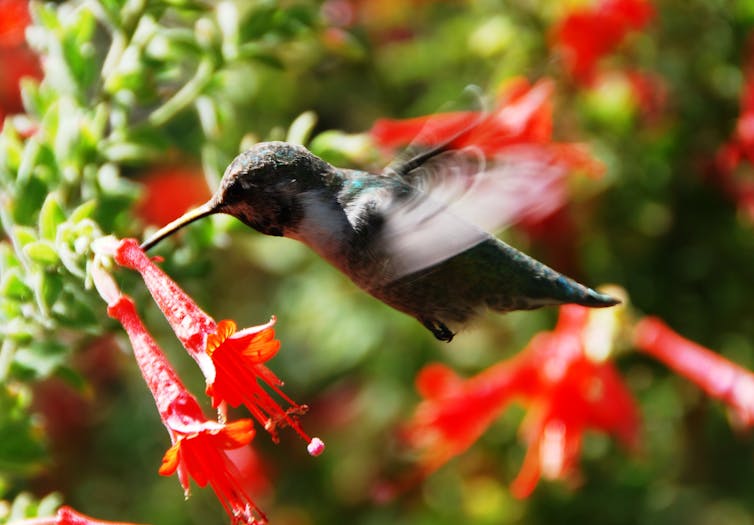
When you hear the word “electricity”, thoughts of power lines or household appliances are probably conjured up in your mind. But electricity is not just a modern human phenomenon – it was around long before us and, in fact, long before planet Earth.
“Electricity” simply refers to the interactions between any electrically charged objects, not just human-made ones, and these interactions are commonly found in the natural world among many animals and plants.
At the small scale, these electrical interactions involve negatively charged electrons and/or positively charged protons – opposite charges attract and like charges repel. But each of these tiny particle interactions can add up, and contribute to creating effects which we can see at the much larger ecological scale in the interactions between animals, plants and their environment.
In a lot of cases, what we are seeing in the natural world is static electricity, which is what you experience when you rub a balloon on your hair and it becomes statically charged. The exact same thing can happen to animals.
As animals run, crawl or fly, their body parts rub on objects in their environment – or even just the air – and this charges them up, just like the balloon rubbing on your head. The amount of charge animals can build up this way is surprisingly high, with many different species accumulating charges that when measured as voltages can be in the region of many hundreds or thousands of volts. That’s more than the voltage that comes out of your plug sockets at home.
We wanted to review whether this static electricity helps animals live their lives. The answer is a resounding “yes”.
Because statically charged objects can attract and repel each other, many different kinds of ecological interactions are affected by them.
The static charges on the feet of geckos help them stick to surfaces, so they can wall-run with ease.
Spiders also love a bit of static electricity; not only are their webs electrostatically attracted towards charged flying insects, but they also use electricity to fly. Several species of spider exhibit a behaviour called “ballooning”, where they let out strands of silk that lift them up into the air like a balloon, and carry them away to disperse and find new homes. It turns out that static electricity in the atmosphere, the type that causes thunderstorms in extreme cases, actually helps spiders in their aviation efforts by statically attracting the charged silk strands upwards into the atmosphere.
It is not just animals that take advantage of these invisible electric forces either. Pollen has actually been shown to jump from flower to insect or bird pollinator without any contact between the two. The static charges of insects and hummingbirds are strong enough to pull pollen through the air, even over several centimetres in some cases.

Jeffrey Eisen / Pexels, CC BY
Many animals can detect electricity too
Because naturally occurring electricity permeates the environment and lives of so many organisms – and has clear ecological value – it seemed likely that some animals may have evolved sensory systems to detect it.
Recent research has discovered that many animal species can indeed detect electricity when it is relevant to their natural ecology. We call this “aerial electroreception”.
Bumblebees and hoverflies can sense the electricity that exists around flowers, and use this information to learn which flowers might have the best nectar stocks. Similarly, part of the “waggle dance”, a series of movements performed by honeybees to communicate to each other where to forage, is also transmitted electrically by the detection of the statically charged bee body shaking around.
It has also now been shown that those flying spiders I mentioned earlier can detect how strong the local atmospheric electrical conditions are, and can then use this information to decide when to attempt take-off.
We are only just beginning to uncover the multiple strands of this newly discovered sense. There are likely hundreds, if not thousands, more species capable of aerial electroreception, and in many more ecological contexts; perhaps a prey animal can detect its approaching predators by the static charge on the predator, or vice versa. There is so much more to be discovered.
Possibly even more important though, is to assess to impact of human activity on this electric ecology.
The magnitude of many human-made electricity sources are comparable, if not greater, than the natural sources of electricity. We might be swamping the electrical senses of key pollinators or interfering with the natural world in other, as yet unknown, ways. While the discovery of this electrical sense is incredibly exciting, it also highlights how little we really know about the ways in which we could be hurting and disturbing the natural world.
————————-
This blog is by Sam England, PhD researcher in Biological Sciences, University of Bristol
This article is republished from The Conversation under a Creative Commons license. Read the original article.
| Sam England |









